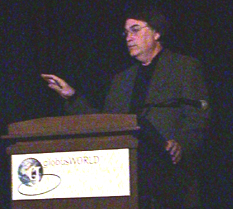Smarr at GlobusWORLD: From Grid to LambdaGrid
1.23.2004 -- Digging into his memory banks and producing some "old photos" of selected GlobusWORLD attendees to prove the point, Calit² director Larry Smarr described Globus as an outgrowth of a state-of-the-art networking experiment conducted at Supercomputing '95. "The conference featured I-WAY," he said, "which stood for Information Wide-Area Year - it was a supernetwork, but it existed for less than a week! It became clear that, for the network to progress, it needed software in the middle, and that was enough to catalyze interest around what was then considered an upstart: Globus."
|
Smarr elaborated that he considers networking the driver of the 21st century. "Parallelism has come to optical networking just as it did to supercomputing," he said. "Parallel lambdas will drive this decade the way parallel processors did the 1990s in the high-performance computing arena" when he was director of the National Center for Supercomputing Applications. Leaving behind shared IP, the network of the future will consist of dedicated light paths that are predictable in performance.
In this context, he described one of Calit²'s flagship research projects, called the OptIPuter. This project is experimenting with linking end-user, scalable PC clusters over IP protocols and lambda connectivity. "We won't need TCP since, in this picture, there will be no network sharing, and hence no network congestion," he said. He imagines a future world based on open-source lambdagrid middleware, visualization, collaboration environments, and data mining/retrieval, all driven by large-data objects, applications research, and educational needs.
By way of example, he pointed to the Biomedical Informatics Research Network, a multi-scale brain imaging federated repository, led by Calit² DeGEM participant Mark Ellisman. "UCSD is the IT and telecom integration center with 'Globus Inside,'" he said, to the amusement of some of the attendees from Intel. In this case, the OptIPuter is driven by online microscopes creating very large biological montage images. Another example is NSF's Ocean Research Interactive Ocean Network (ORION), a proposed $200M (in hardware) project to build out ocean observatories and collect the data, BIRN-style, into a federated repository for all domain scientists to share.
One of the steps on the way to realizing this infrastructure, Smarr said, was an experiment at SC03, led by Phil Papadopoulos of SDSC, to build, in real time at the Sun Microsystems exhibit, a 128-node Sun cluster running Globus and some applications. The experiment took just 75 minutes. And extending middleware, such as Globus, for lambda-networked systems will support scaling this experiment to include lots of clusters, which will form a "distributed virtual computer" as a single abstraction for the end user - just what the end user needs.
|
The current barrier to this vision, said Smarr, is the low throughput of today's Internet, which has a "glass ceiling of about 50 Mbps," some 1/1000 of available backbone speed. Today's throughput is typified by the 12.4 Mbps achieved in an experiment transferring satellite data coast to coast from UCSD's Scripps Institution of Oceanography to NASA/Goddard. In contrast, a demo between NCSA and SDSC using a dedicated path achieved 9.3 Gbps out of the available 10. "The problem is not the fiber but fact that it's shared," said Smarr.
UCSD is prototyping a campus-scale OptIPuter, linking some eight locations on campus and using a Chiaro Networks "Enstara" router (the first installed) capable of up to 6.4 Tbps within the testbed. Vendor donations from IBM and Sun Microsystems are helping build out the system. Complementing this infrastructure will be ultra-resolution displays driven by graphics clusters scaling from 35M pixels now to 100M pixels some time in the future.
And the OptIPuter is expected to become national-scale in 2004. Partners in San Diego and Chicago will be linked through the National Lambda Rail, serving very-high-end experimental and research applications with 4 x 10 Gbps wavelengths initially (expected in August) and scaling to 40 x 10 Gbps wavelengths at buildout.
"In fact, the OptIPuter was born global," emphasized Smarr, pointing to previous work done by the Dutch at the University of Amsterdam via NetherLight who are also partners in the OptIPuter project. "LambdaGrids are beginning to link the world, and we're starting to talk about the GLIF - the Global Lambda Integrated Facility."
Globus, of course, is at the heart of the OptIPuter and like experiments, and Smarr was pleased to note that it's stretching in new directions and beginning to gain broad acceptance.



